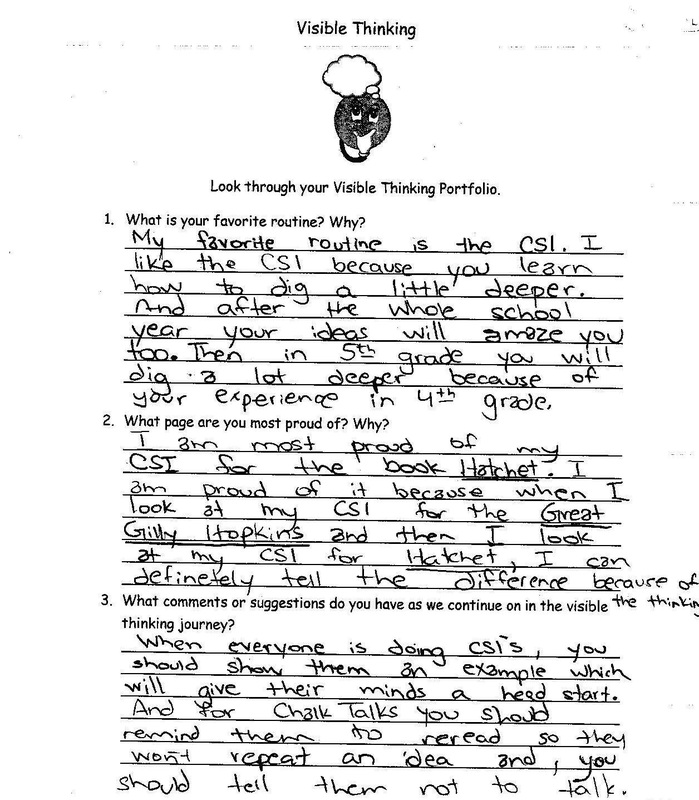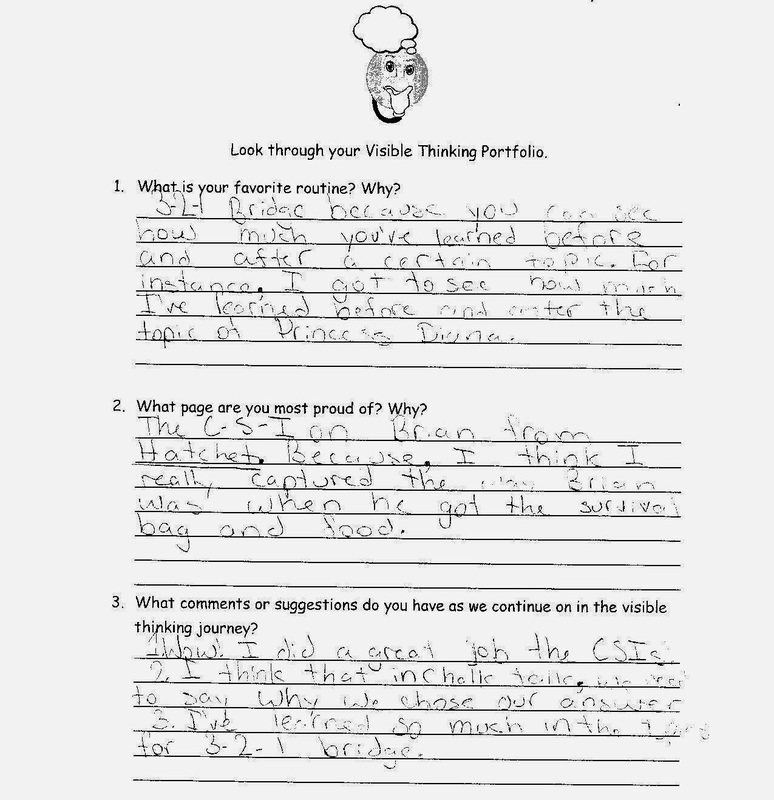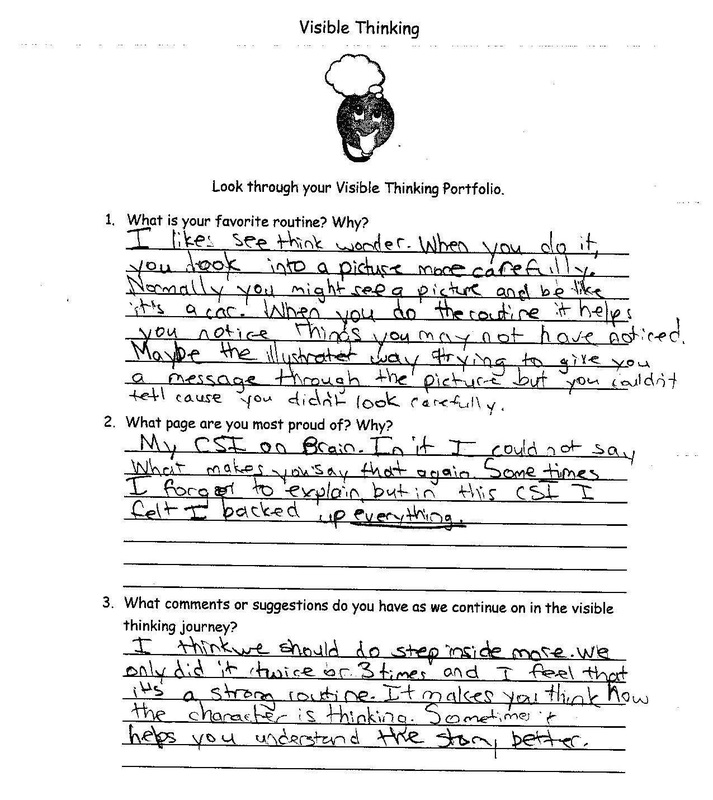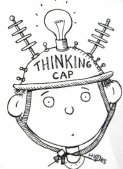Thinking
Student Reflections On A Year of Thinking
In the midst of handing back papers and cleaning out desks in June, we often ask students to reflect on the year's learning. A 4th grade teacher had her students keep a Visible Thinking folder this year. In it, students put documentation of their responses to Visible Thinking routines. This teacher thought that a longitudinal collection might help her document and understand growth in student thinking. When she asked her students to self-reflect on their work, she was surprised at the depth of metacognition revealed in the responses. Here are a couple of samples:
Teacher Reflections on Student Thinking
Ron Ritchhart was in Troy the week of the Project Zero Conference in Clarkston and visited Bemis. As we looked at student work on boards around the school, he suggested that each time a routine is completed, teachers should look at the thinking with these three ideas in mind:
What do you notice?
What surprises you?
Where will you go next?
What do you notice?
What surprises you?
Where will you go next?
Finding the Thinking In Student Work
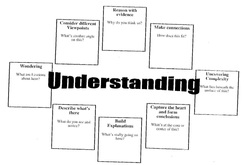
Visible Thinking routines are instructional strategies developed to help teachers provide opportunities for students to generate deeper thinking and understanding throughout their learning. Incorporating Visible Thinking routines into instruction does not necessarily ensure deeper student thinking and under any circumstances, there is always opportunity to cultivate thinking even further. This is why tools have been developed to help advance cultures of thinking in classrooms and schools. You can read more about this piece of Visible Thinking at http://pzweb.harvard.edu/vt/VisibleThinking_html_files/05_SchoolWideCultureOfThinking/05b_Introduction.html
An element of this work is to look closely at student work, reflect on thinking found in the work then use this information to create opportunities for students to further develop their thinking.
A tool for doing this is to use the "Understanding" map that I have passed out when I have visited schools. Each of the eight boxes on the map has a "thinking move" identified by Ron Ritchhart. Searching for evidence of these thinking moves will inform your teaching and give you a guide for deepening the thinking in your classroom. If you don't happen to have an understanding map, there is a list of the "thinking moves" further down on this page. There is more information about "thinking moves" in Chapter 2 of the Making Thinking Visible book.
An element of this work is to look closely at student work, reflect on thinking found in the work then use this information to create opportunities for students to further develop their thinking.
A tool for doing this is to use the "Understanding" map that I have passed out when I have visited schools. Each of the eight boxes on the map has a "thinking move" identified by Ron Ritchhart. Searching for evidence of these thinking moves will inform your teaching and give you a guide for deepening the thinking in your classroom. If you don't happen to have an understanding map, there is a list of the "thinking moves" further down on this page. There is more information about "thinking moves" in Chapter 2 of the Making Thinking Visible book.
What Is The Story of Learning In Your Classroom?
This is a question that Ron Ritchhart asks teachers to consider as they design classroom experiences. We can know the learning that has occured in our classrooms by the accuracy with which students answer questions during lessons or on tests. But how do we know about the type of thinking and understanding that is going on? The possibility that the thinking our students are doing is not always what we believe it to be or what the curriculum intends it to be can become very clear when we ask students to unpack their thinking as we use routines. When we find that learning connections and concept building need some redirection or correction, a lesson or two that models strong responses to a routine will often put students on the right track.
In the Making Thinking Visible book, there is an excellent description of how this occurred in Mark Church's classroom. The section is in Chapter 8 and is titled The Challenges of Making THinking Visible in a Mathematics Class and Beyond: The Case of Mark Church.
In the Making Thinking Visible book, there is an excellent description of how this occurred in Mark Church's classroom. The section is in Chapter 8 and is titled The Challenges of Making THinking Visible in a Mathematics Class and Beyond: The Case of Mark Church.
Thinking about thinking
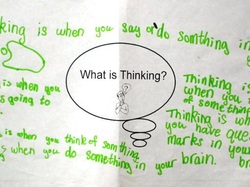
CAFE Makes Thinking Visible
If you are using CAFE to teach reading strategies in your classroom, your CAFE board makes visible not only the thinking readers must use to be successful but also the skills that your readers are working to achieve. It was quite amazing to find that, when responding to the prompt "What Is Thinking?", first graders list many of the words and ideas that you use when teaching CAFE straetgies and then post on your CAFE board. Here are some of the of respnses and ideas from Laura Galante's first grade students:
Thinking is:
wondering, visualizing, when you have question marks in your brain, making a picture in your brain, what makes sense, making a movie in your brain, retelling, understanding, comprehending, solving anything, a word that fits
These responses are evidence that when you make the thinking visible through your CAFE routines, students not only use them but also internalize them so they are always accessible.
If you are using CAFE to teach reading strategies in your classroom, your CAFE board makes visible not only the thinking readers must use to be successful but also the skills that your readers are working to achieve. It was quite amazing to find that, when responding to the prompt "What Is Thinking?", first graders list many of the words and ideas that you use when teaching CAFE straetgies and then post on your CAFE board. Here are some of the of respnses and ideas from Laura Galante's first grade students:
Thinking is:
wondering, visualizing, when you have question marks in your brain, making a picture in your brain, what makes sense, making a movie in your brain, retelling, understanding, comprehending, solving anything, a word that fits
These responses are evidence that when you make the thinking visible through your CAFE routines, students not only use them but also internalize them so they are always accessible.
Blogging About Thinking
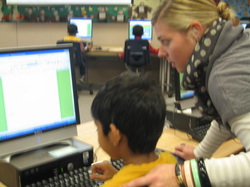
The students in this first grade class took their ideas about "What Is Thinking?" to the computer lab, posted them on their class blog and then responded to each other's ideas. Twenty-first Century learning at its best! Try it the next time you take your class to the computer lab!
Thinking moves
In his book, Making Thinking Visible, Ron Ritchart identifies eight "thinking moves" or teaching straetgies. Including these strategies in lesson helps ensure that students are developing deep and enduring concept understanding. These "moves" or strategies are:
1. Observing closely and describing what's there
2. Building explanations and interpretations
3. Reasoning with evidence
4. Making connections
5. Considering different viewpoints and perspectives
6. Capturing the heart and forming conclusions
7. Wondering and asking questions
8. Uncovering complexity and going below the surface of things
1. Observing closely and describing what's there
2. Building explanations and interpretations
3. Reasoning with evidence
4. Making connections
5. Considering different viewpoints and perspectives
6. Capturing the heart and forming conclusions
7. Wondering and asking questions
8. Uncovering complexity and going below the surface of things
Thinking Moves In Student Language
This is a poster you can use in your classroom to make students aware of the types of thinking they are doing:
I am thinking and understanding when I:
1. Look closely and describe details
2. Explain ideas by putting thoughts into words and giving details
3. Give reasons for my explanations
4. Make connections
5. Listen to and think about the ideas of others
6. Know the main idea
7. Wonder and ask questions
8. Think beyond my first idea or answer
1. Look closely and describe details
2. Explain ideas by putting thoughts into words and giving details
3. Give reasons for my explanations
4. Make connections
5. Listen to and think about the ideas of others
6. Know the main idea
7. Wonder and ask questions
8. Think beyond my first idea or answer
